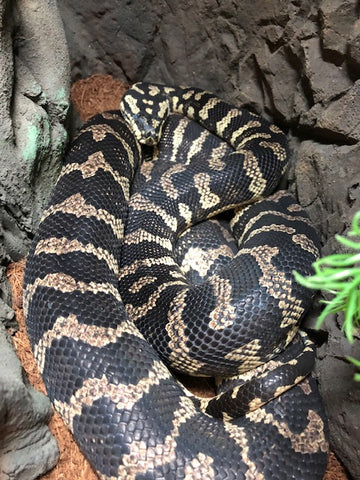Exploring the Fascinating Jungle Carpet Python
The jungle carpet python, scientifically known as Morelia spilota cheynei, is a captivating member of the Pythonidae family, belonging to the “morelia spilota” genus. Renowned for their distinctive appearance and docile demeanor, jungle carpet pythons are among the most sought-after species in the realm of carpet pythons.
Physical Characteristics: These majestic serpents boast a classic triangular head adorned with a blunted snout, complemented by elliptical pupils and dark irises. Notably, they possess heat-sensitive pits near their nose and jaw, aiding in thermoregulation. A defining feature is the striking stripe that typically commences behind the eyes, traversing through and encircling the front of their snout.
Coloration and Camouflage: Adorned with a mesmerizing color pattern, jungle carpets exhibit vibrant black and yellow markings across their dorsal surface. This intricate design serves a functional purpose, aiding in camouflage amidst the lush foliage and dappled light of their rainforest habitat.
Origins of the Name: The moniker “carpet python” is believed to stem from the resemblance of their scales to the patterns found on traditional carpets, showcasing nature’s artistry in their intricate skin.
Size and Growth: Upon reaching adulthood, jungle carpet pythons typically measure between 4 to 5 feet in length, making them relatively modest in size among carpet python subspecies. Females tend to outgrow males, with some individuals stretching up to a remarkable 8 feet in length.
Behavior and Habitat: Nocturnal by nature, these serpents are most active during the night, opting to bask and rest in the safety of tree branches during the day. They exhibit a preference for habitats in close proximity to water bodies, such as rivers or streams, seeking refuge in trees within dense subtropical rainforests and river basins along the coast.
Dietary Preferences: Jungle carpet pythons are obligate carnivores, preying on a variety of small creatures including lizards, birds, small mammals, and frogs. In captivity, their diet typically consists of rats, mice, and juvenile rabbits.
Predatory Tactics: As ambush predators, jungle carpets rely on stealth and patience to secure their meals. They lie in wait, concealed amongst foliage, before seizing their unsuspecting prey and employing constriction to facilitate ingestion.
Lifespan: Under optimal conditions and attentive care, these magnificent creatures can thrive for up to 30 years in captivity. In the wild, their lifespan is slightly shorter, ranging from 15 to 20 years.
Natural Habitat: Endemic to the northeastern region of Queensland, Australia, jungle carpet pythons inhabit a confined geographical range. While other carpet python subspecies, such as Diamond Carpets or Southern Carpets, are distributed across Australia, New Guinea, and northern New Zealand, jungle carpets specifically favor the verdant realms of subtropical rainforests and river basins.
Venomous Nature: Contrary to misconceptions, jungle carpet pythons are nonvenomous. However, when threatened, they may resort to defensive measures, including striking to deter potential predators. Renowned for their placid temperament, these pythons are cherished as pets owing to their ease of maintenance and propensity for successful reproduction in captivity.
In essence, the jungle carpet python captivates enthusiasts with its exquisite beauty, gentle disposition, and remarkable adaptability, embodying the allure of the natural world’s diverse wonders.




